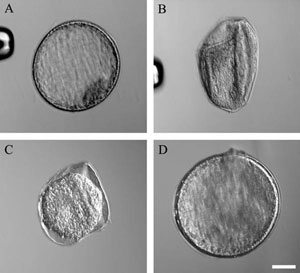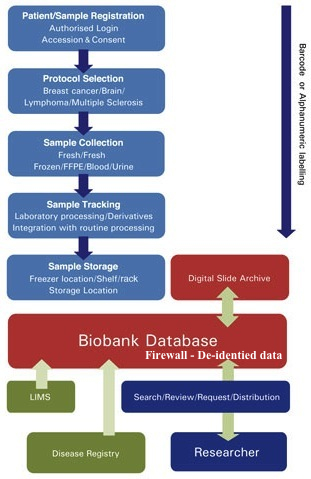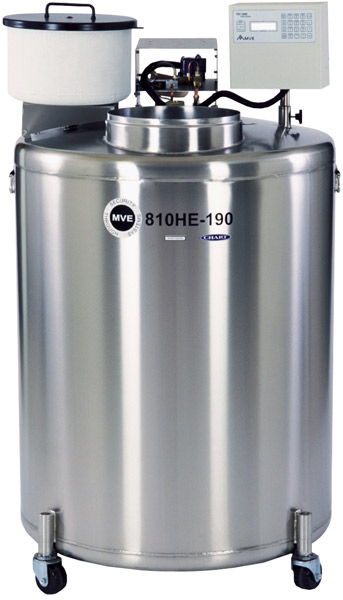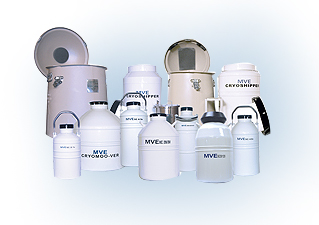Specimen Handling and Retrieval
| Archival services: | Internal Rates | External Rates |
|
Flash freezing and - 80 storage
|
$4 (per vial) |
$5 (per vial) |
| Storage in buffer of choice (RNA later, DNA later, AllProtect, DMSO, Lysis*) | TBA | TBA |
| Vitrification (cryo-preservation) TBA | TBA | TBA |
| Molecular partition (DNA, RNA) TBA | TBA | TBA |
| Cell culture TBA | TBA | TBA |
|
Retrieval services:
|
||
|
|
||
| Simple retrieval |
$59 (per vial) |
$70 (per vial) |
| Shipping or handling in dry-ice | TBA | TBA |
| Data search | TBA | TBA |
| Morphological Partition (eg. peri or intra tumor tissue) | TBA | TBA |
| Molecular partition (DNA/RNA) TBA | TBA | TBA |
| Frozen shipping service (cryo-preserved) TBA | TBA | TBA |
For more informations about archival or retrieval, please contact us.
Sample Handling and Retrieval:
Specimens are handled first by the anatomic pathology Grossing Room, or directly by the BioBank staff, in a state of the art facility that ensures the specimen's morphological and molecular integrity from its reception to its archival. The staff is trained in methods of pathology grossing, dissection, preservation and cryogenic archival. The specimens are flash frozen and maintained at -80 degree Celsius to avoid degradation.
In the near future, the BioBank will replace its -80 storage by cryogenic vats capable of archiving 40,000 2ml vials at -196 degree Celsius. The switch to cryogenic storage is not only dictated by an increased capacity and specimen temperature security (-80 freezers not only fail mechanically, but also require electricity, which may not be available in emergency situations, such as hurricane or earthquake or even brow and black outs), but also by the goal of Stony Brook University to remained energy efficient. More importantly, maintaining specimens in cryogenic storage will allow the BioBank to archive primary cell lines, as well as keep the specimen in a state of 'suspended animation', or vitrification. Vitrification is the state in which a given biological specimen is no longer frozen and solid but rendered a glass-like, highly viscous liquid state. Both the morphological and the molecular structures of the specimen remain integral, as the cooling process prevents the formation of ice crystals and dehydration, as well as the breakage of fatty acid chains (all of which still happens during long-term -80 degree storage).
Retrieval of the samples currently consist in aliquoting at -80 degree Celsius, but will be replaced by the same system of controlled cooling/heating from cryogenic temperature to whatever conditions is requested by the researcher. Each sample requested will be handle with the same integrity and safety measures as when archiving. We will also be able to ship in cryogenic containers (called dryshippers) or in dry ice, or in the buffer of the researcher's choice.
|
(from:http://www.chartbiomed.com/getattachment/db6344e5-ed7c-4a36-92f8-5ea9b0809fe7/.aspx) |
MVE cryogenic dryshipper (from: http://www.chartbiomed.com/getattachment/db6344e5-ed7c-4a36-92f8-5ea9b0809fe7/.aspx) |

Vitrified embryo (from http://vetmed.tamu.edu/equine-embryo-laboratory/clinical-services/embryo-vitrification)
Data Management:
The BioBank uses Freezerworks UnlimitedTM, which allows the tracking of all relevant data as well as the physical tracking of each sample to its location in the freezer. The flexibility of Freezerworks allows the BioBank team to collect text, but also images and PDF documents pertaining to a specific specimen. With an easy export function, Freezerworks is compatible with any platform and web-interface database.
The SOAP protocol included in Freezerworks also allows our team to 'serve' the database on our secure intranet to a wireless Freezerworks device app on iPads and iPods, allowing our technicians to be mobile while maintaining or changing elements of the database, whether in the cryogenic storage room or in the laboratory.
A fully searchable, de-identified, database will soon be made available to the research community which will include links to molecular collection databases, such as GenBank and Dryad, as well as de-identified imaging of representative and diagnostic slides/CT-Scan/MRI/X-Ray.
- Day-to-day, biobank-based database, behind a secure firewall
- Customized online version of data holdings (fully de-identified)
- External interface compatibility/Data transfer
- LIMS
- Registries
- Other databases (such as NCBI Genbank, OMIM, etc)

Structure of the BioBank data acquisition, aggregation and standardization
 Biobank MVE cryogenic vapor phase vat
Biobank MVE cryogenic vapor phase vat